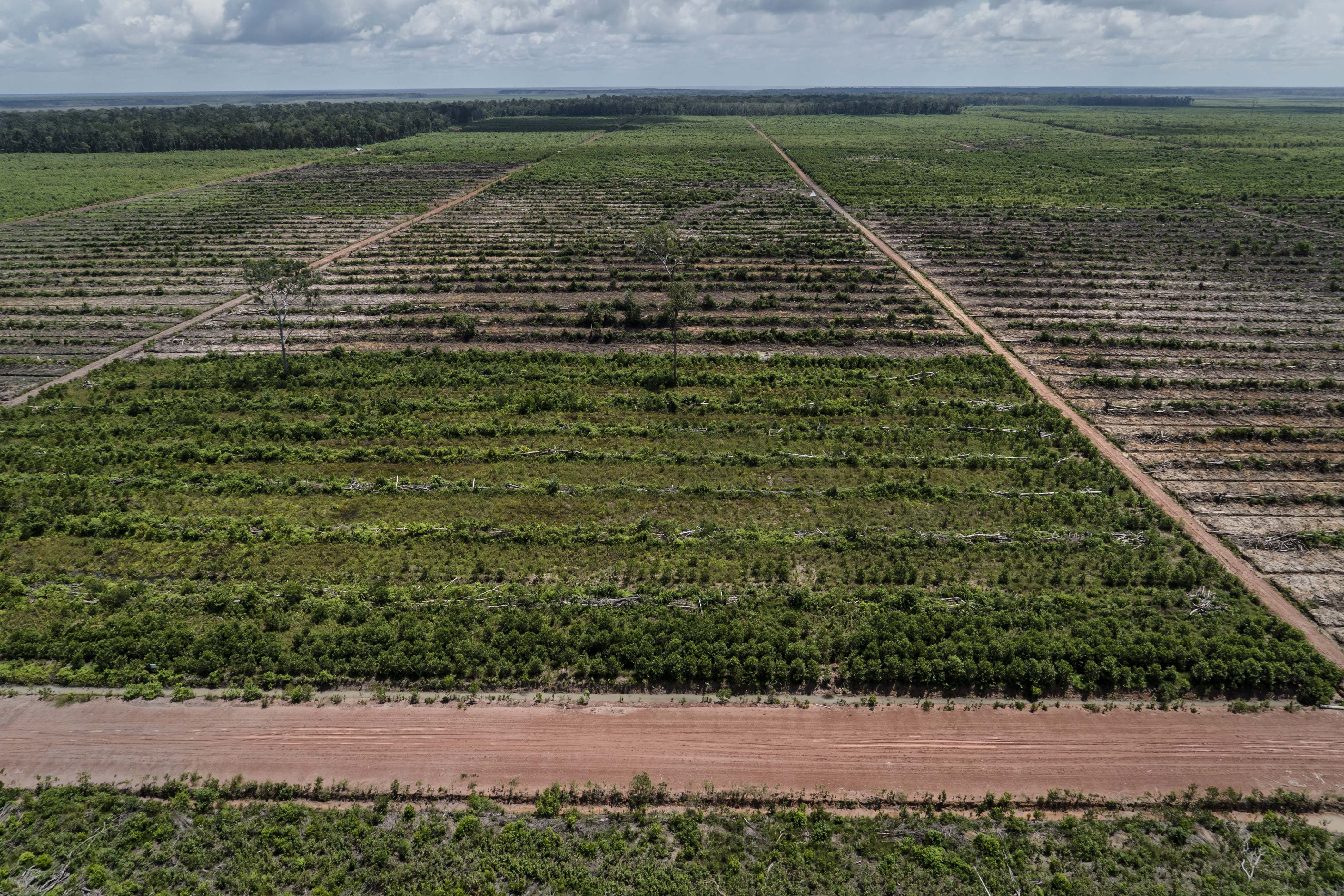
Pulp-and-paper Driven deforestation in Indonesia accelerates in 2022

Analysis by TheTreeMap, conducted using Sentinel-2 and Planet/NICFI satellite imagery.
The rate of deforestation caused by the production of pulp, a wood product used to make paper, has decreased significantly in Indonesia since reaching its highest point in 2011 (as seen in the white bars in Figure 1).
Despite this positive trend, the pulp and paper industry in Indonesia continues to cause extensive deforestation and exploitation of peatlands.
In 2022, a larger area of primary forest was converted to plantations (acacia and eucalyptus) than the previous year, with 25,887 hectares being cleared in 2022 and 12,320 hectares cleared in 2021 (white bars in Figure 1), indicating a doubling in pulp-driven deforestation and the highest level since 2014.
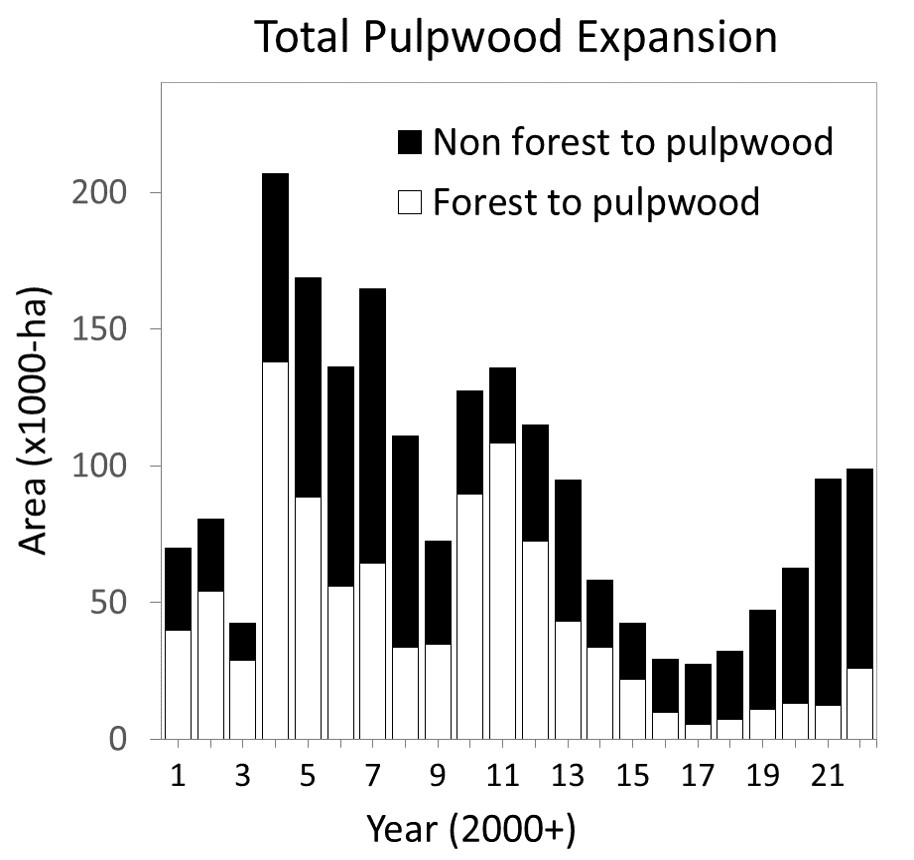
Surprisingly, fewer peatlands were converted, with 24,000 ha cleared in 2022 compared to 26,111 ha cleared in 2021 (white bars; Figure 2), representing a 8% decline.
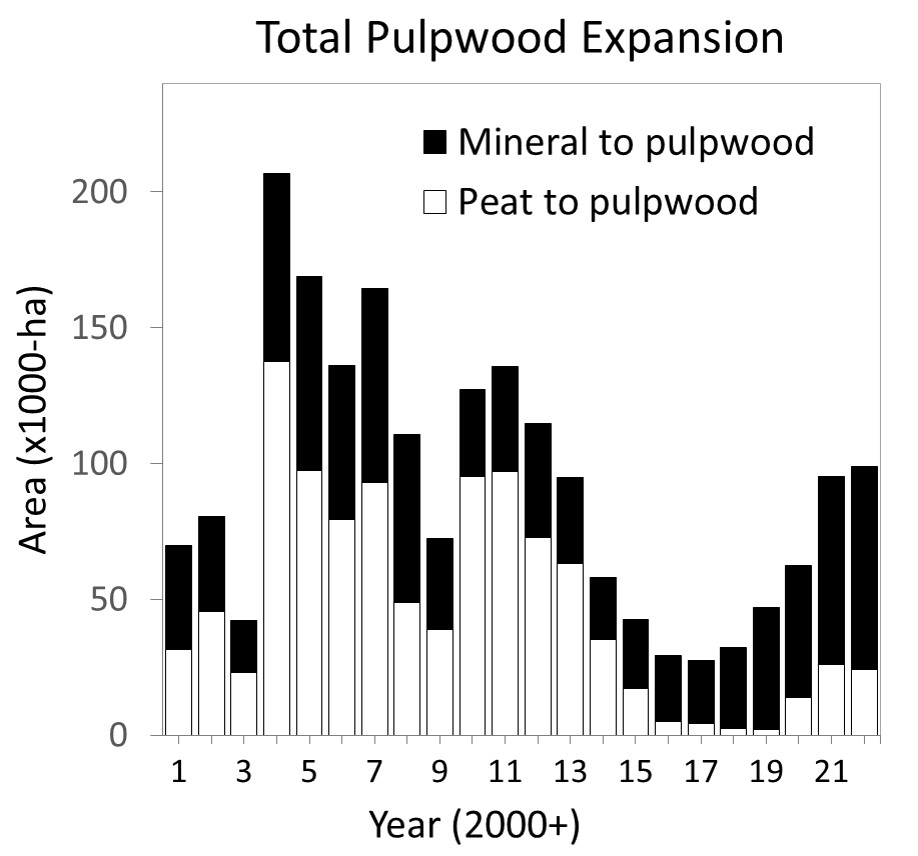
Almost all this pulp-driven deforestation occurred in Kalimantan (25,077 ha were cleared, light bar in left panel; Figure 3).
In Kalimantan, plantations expanded at a record high of 66,032 ha in 2022 (light and dark bars in left panel; Figure 3 or Figure 4).

Peatlands conversion in Kalimantan also increased, with 12,898 ha cleared (Figure 4), a 86 % increase since 2021 (6,937 ha converted).

Two companies: Mayawana Persada (Alas Kusuma) and Industrial Forest Plantation (Nusantara Fiber) are responsible for 70% (18,098 ha cleared) of total pulp-driven deforestation recorded in 2022 (25,887 ha). See Tables 1 and 2 at the end of document and interactive map over Mayawana Persada.
Alas Kusuma has Forest Stewardship Council (FSC) certificates via two logging concessions subsidiaries, PT Sari Bumi Kusuma and PT Suka Jaya Makmur, but destroys orangutan habitat and drains peatlands with deep canals. Among the prominent buyers of Alas Kusuma’s plywood is Itochu Corporation.
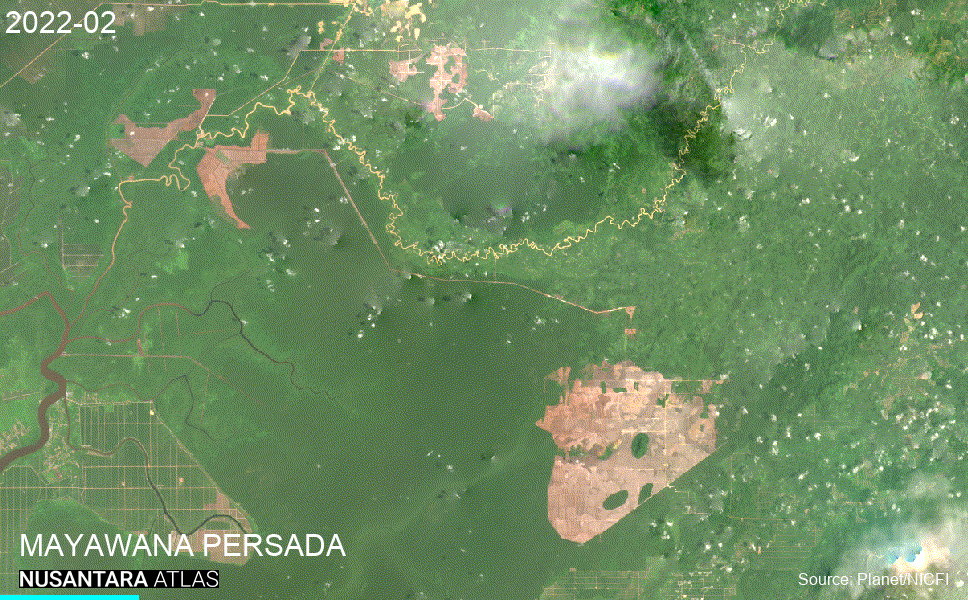
Nusantara Fiber (Industrial Forest Plantation ) has connections to Indonesia’s giant pulp and paper company Royal Golden Eagle (RGE), although RGE have denied any association.
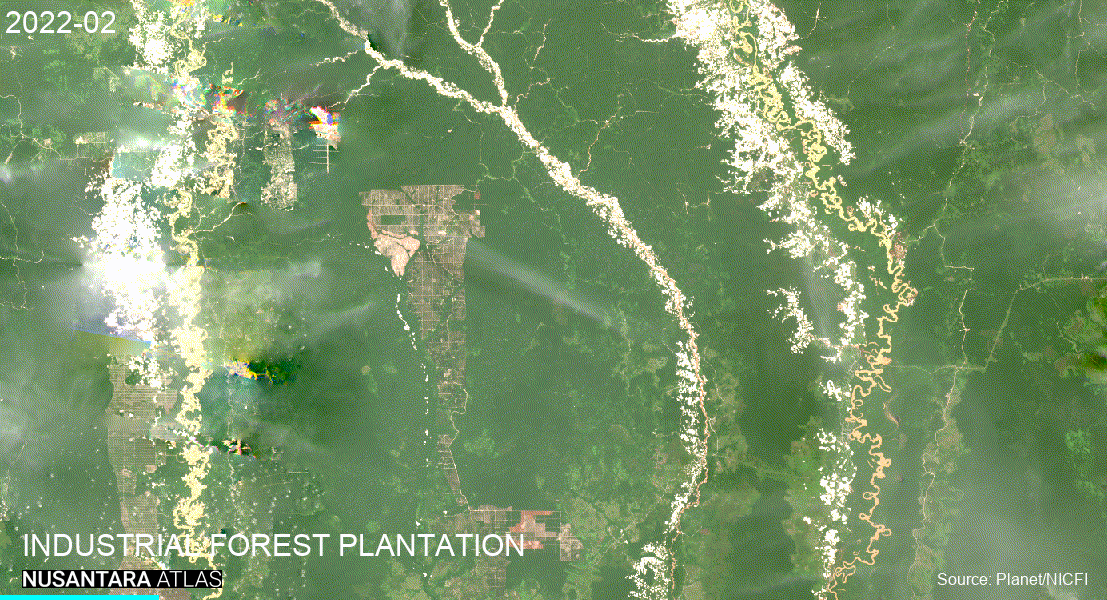
Another FSC-certified company is pulping natural forest in Papua to produce eco-friendly paper.
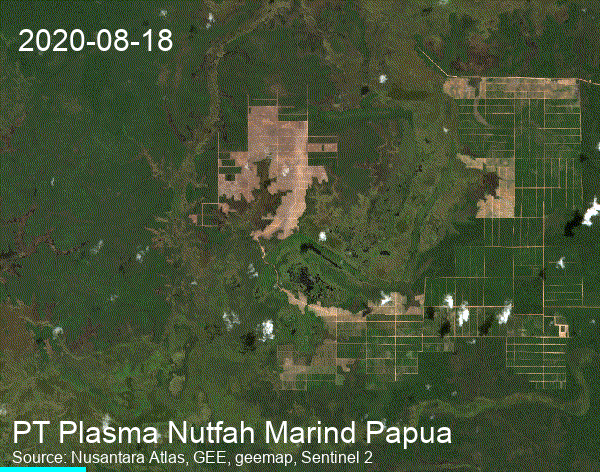
Over the past 22 years, the expanding pulp and paper industry in Indonesia established 3.05 Mha of plantations, the size of Belgium, and converted 1.02 million hectares of forest in the process, destroying animal habitats and biodiversity while turning vast areas of carbon sink swamp forests into fire-prone wastelands.
This deforestation represents 10% of Indonesia’s total loss of old-growth forests (10.19 Mha) recorded over the two decades, including 630,000 ha of ecologically sensitive peat-swamp forest cleared. In addition, the industry drained 1 million hectares of peat swamps for plantations, about one-third of the total Indonesian peat swamp forest destruction of 3.2 million hectares over two decades (2001-2021).
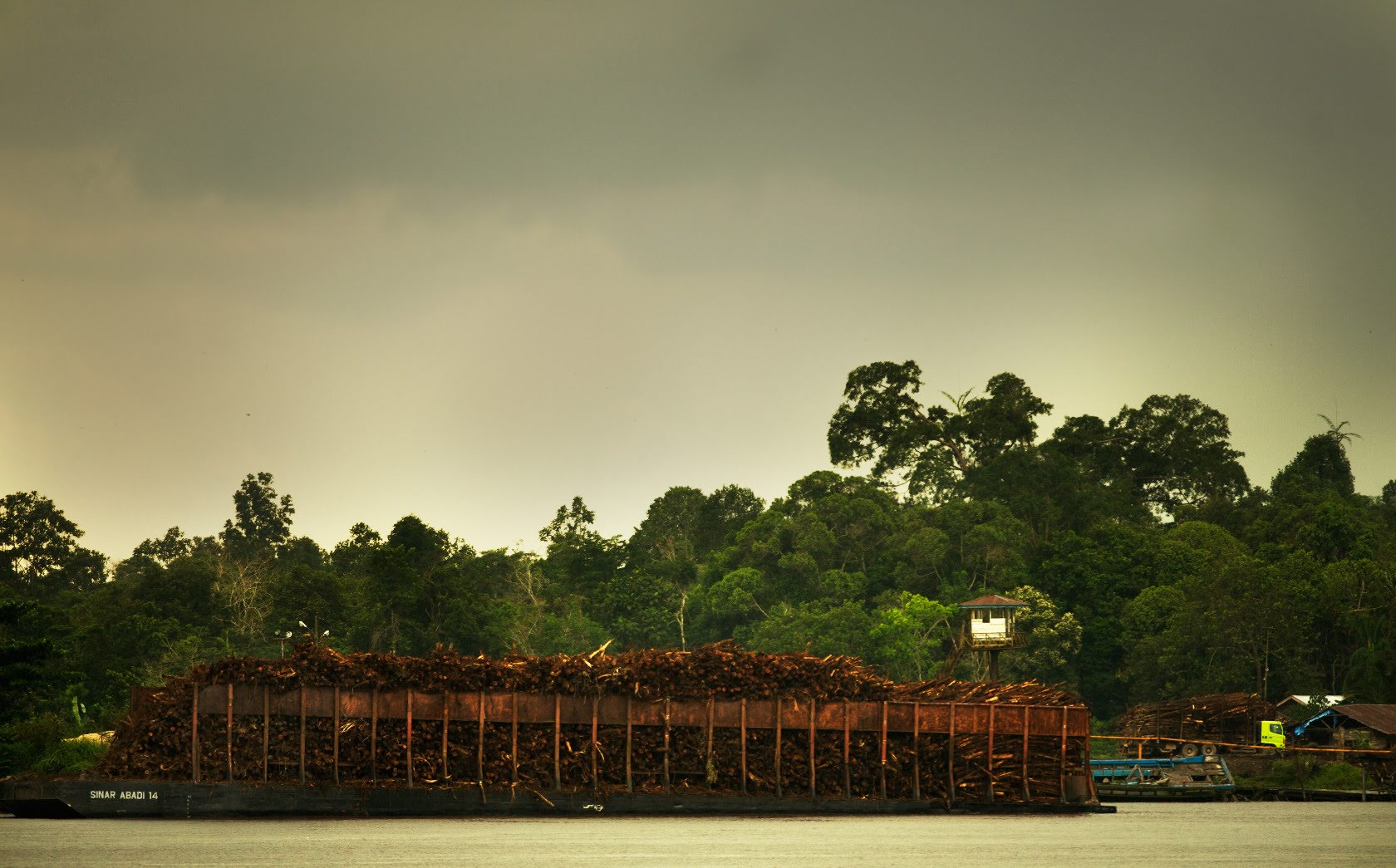
Interactive map
Table 1. The list of companies who developed new plantations at the expense of forest in 2022, ranked from worst to least forest destroyer. This table includes the amount of forest on mineral soils converted and the amount of peat-swamp forest converted.
| Company Name | Group | Concession Area (Ha) | Location | Total Deforestation | |
| 1 | Mayawana Persada | Alas Kusuma | 138,809 | West Kalimantan | 11,308 |
| 2 | Industrial Forest Plantati0N | Nusantara Fiber | 101,416 | Central Kalimantan | 6,790 |
| 3 | Jaya Bumi Paser | 23,597 | East Kalimantan | 1,239 | |
| 4 | Sendawar Adhi Karya | 24,077 | East Kalimantan | 807 | |
| 5 | Intraca Hutani Lestari | 41,611 | North Kalimantan | 535 | |
| 6 | Baratama Putra Perkasa | 36,038 | Central Kalimantan | 440 | |
| 7 | Grace Putri Perdana | 29,221 | Central Kalimantan | 420 | |
| 8 | Siemon Agro | 10,161 | Central Kalimantan | 369 | |
| 9 | Hutan Rindang Banua | Sinar Mas Group (UFS-DSS) | 247,618 | South Kalimantan | 276 |
| 10 | Fajar Wana Lestari | 17,697 | West Kalimantan | 251 | |
| 11 | Plasma Nuftah Marind Papua | Moorim | 64,437 | Papua | 205 |
| 12 | Taiyoung Engreen | 4,678 | South Sumatera | 141 | |
| 13 | Dharma Hutani Makmur | RAPP open market suppliers | 55,605 | East Kalimantan | 138 |
| 14 | Hutan Produksi Lestari | 10,029 | Central Kalimantan | 130 | |
| 15 | Buana Megatama Jaya | 43,111 | West Kalimantan | 119 | |
| 16 | Bakayan Jaya Abadi | Nusantara Fiber | 15,083 | East Kalimantan | 110 |
| 17 | Selaras Inti Semesta | Medco | 166,751 | Papua | 91 |
| 18 | Indosubur Sukses Makmur | 28,215 | East Kalimantan | 80 | |
| 19 | Bukit Raya Mudisa | RAPP supply partner | 28,004 | West Sumatera | 79 |
| 20 | Sumatera Riang Lestari | RAPP supply partner | 49,507 | Riau | 64 |
| 21 | Muara Sungai Landak | 11,847 | West Kalimantan | 35 | |
| 22 | Silva Rimba Lestari | 88,717 | East Kalimantan | 25 | |
| 23 | Wanakerta Ekalestari | 26,608 | West Kalimantan | 12 |
Table 2. The list of companies who developed new plantations at the expense of peatlands in 2022, ranked from worst to least peatland destroyer. This table includes the amount of forest and non forest on peat converted.
| No | Company Name | Group | Concession Area (Ha) | Location | Clearing on Peat |
| 1 | Mayawana Persada | Alas Kusuma | 138,809 | West Kalimantan | 6,762 |
| 2 | Siemon Agro | 10,161 | Central Kalimantan | 3,656 | |
| 3 | Bumi Mekar Hijau | Sinar Mas Forestry Affiliated | 250,272 | South Sumatera | 2,520 |
| 4 | Sumatera Riang Lestari | RAPP supply partner | 49,507 | Riau | 1,089 |
| 5 | Industrial Forest Plantation | Nusantara Fiber | 101,416 | Central Kalimantan | 1,022 |
| 6 | Tiesico Cahaya Pertiwi | 4,678 | South Sumatera | 867 | |
| 7 | Buana Megatama Jaya | 43,111 | West Kalimantan | 745 | |
| 8 | Bumi Andalas Permai | Sinar Mas Forestry Affiliated | 189,529 | South Sumatera | 735 |
| 9 | Sba Wood Industries | Sinar Mas Forestry Affiliated | 136,612 | South Sumatera | 691 |
| 10 | Baratama Putra Perkasa | 36,038 | Central Kalimantan | 297 | |
| 11 | Hutan Ketapang Ind (Dh. Kertas Basuki R) | 97,979 | West Kalimantan | 136 | |
| 12 | Rimba Hutani Mas | Sinar Mas Forestry Affiliated | 102,261 | Jambi | 48 |
TheTreeMap endeavours to protect tropical forests through scientific research and advanced monitoring platforms. We are cartographers, remote sensing engineers, software developers, and field investigators. We empower civil society with the tools to detect deforestation in real-time and ensure what happens on the ground is fair, transparent, and democratic. We build systems that check the deforestation footprint of agribusinesses in tropical forests to ensure sustainable production. Our work is based on the premise that no one wants food and other products to be the cause of forest destruction.